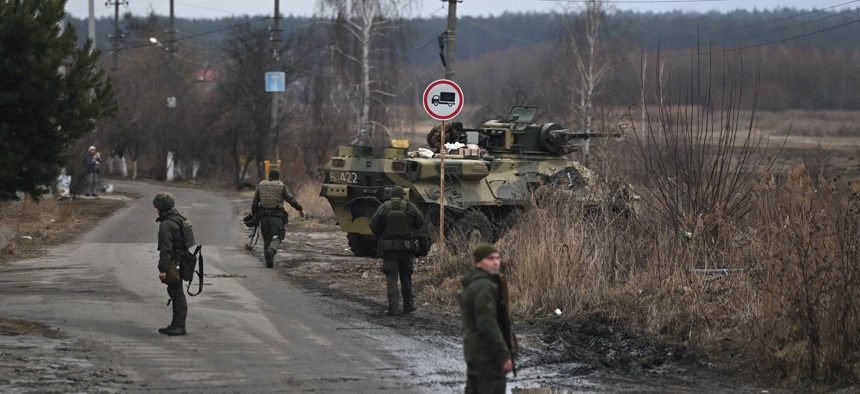
Ukrainian servicemen stand near a BTR-3 armored personnel carrier to the northwest of Kyiv on February 24, 2022. DANIEL LEAL/AFP via Getty Images
The Battle for Ukraine: What We Know So Far
Ukrainians fought back as Russian armor pushed toward cities, U.S. says. And more Americans are deploying to NATO’s eastern front.
Russian air and land forces are pressing into Ukraine from three sides in Europe’s first full-scale military conflict in decades, and also its first of the social-media era. Statements, video, and still images captured and distributed by officials, militaries, journalists, the public, and inevitably, provocateurs and propagandists, suggest that the three-way Russian advance is being contested yet moving ahead.
The fighting apparently began with Russian missile strikes around 9:30 p.m. Eastern time on Wednesday.
“It is likely that you will see this unfold in multiple phases. How many, how long, we don’t know. But what we are seeing are initial phases of a large-scale invasion,” a U.S. senior defense official told reporters in Washington early on Thursday. “Thus far, we have seen an advance on what are essentially three main axes of assault.”
One is northward from Crimea toward Kherson; another southward “basically from Belarus to Kyiv”; and the third from Belarus southwest toward Kharkiv, Ukraine’s second-largest city.
“These three axes are what we believe, clearly designed to take key population centers,” the official said. “I’m saying they’re making a move on Kyiv…They have every intention of decapitating the government and installing their own method of governance.”
“We see the heaviest fighting in and around Kharkiv, right now,” the official said.
Russian forces had fired more than 100 missiles, mostly short-range ones but also medium-range missiles and cruise missiles from warships in the Black Sea, the official said.
As well, “They used approximately 75 fixed-wing heavy and medium bombers as a part of this initial onslaught,” said the official.
“The targets thus far…have been primarily focused on military and air defense—so barracks, ammunition warehouses, nearly 10 airfields targeted. We do not have a good sense of total damage,” or casualties, the official said.
U.S. officials had not yet confirmed reports of Russian ground troops in Ukraine. But local reporting and social media, including from Ukrainian government sources, showed images across the country of downed aircraft, destroyed tanks, civilian casualties and captured Russian troops.
On Facebook, the Ukrainian Land Forces posted a video on Thursday purporting to show Russian equipment being destroyed by the Ukrainian military. The Ukrainian Ministry of Defense also claimed that troops destroyed three Russian tanks and two Russian soldiers had been captured.
CNN reported that Russian “airborne forces” had captured the Antonov airport outside of Kyiv, showing video of men in uniforms carrying weapons and equipment. The reporter, Matthew Chance, said the soldiers were setting up an airbridge to bring in more Russian forces. The New York Times also reported video footage of Russian military helicopters attacking the airport located in Hostomel.
Ukrainian military buildings and equipment were also attacked.
Emine Dzheppar, Ukraine’s first deputy minister of foreign affairs, tweeted a video circulating online purportedly showing a Russian military jet firing on a civilian location in Kharkiv.
As of midday Eastern time, 40 Ukrainian soldiers were killed and more injured, Oleksiy Arestovich, an adviser to the Ukrainian president, told the New York Times.
The invasion is also being witnessed from space. An image captured by satellite company Planet purports to show black smoke billowing from Chuhuiv Air Base in Ukraine’s Kharkiv Oblast.
In Ukraine’s Chernobyl exclusion zone, Russian troops seized the Chernobyl nuclear power plant, Mykhailo Podolyak, an aide to Ukrainian President Volodymyr Zelenskyy. told Reuters. The site of the worst nuclear disaster in history is still contaminated from radioactive material.
Zelensky, in a tweet, said that he and French President Emmanuel Macron called for the establishment of a no-fly zone over Ukraine, but as of now it’s unclear how it would be enforced.
Since January, the Defense Department has alerted some 8,500 U.S. troops to be on stand by for the NATO Response Force and ordered another 5,000 to deploy to NATO countries like Poland in an effort to assure allies and deter Russian aggression as intelligence warned of the potential for an invasion of Ukraine.
On Thursday, President Joe Biden announced that he had approved U.S. troops to head to Germany. The deployment involves 7,000 service members, most of them from the 1st Armored Brigade Combat Team and 3rd Infantry Division from Fort Stewart, Georgia. Other troops from Fort Bragg, in North Carolina, will deploy in the coming days to serve as enablers, mostly in transportation and artillery, a senior defense official said Thursday.
Once they arrive in Germany, the troops could be moved elsewhere in Europe to support a range of missions as needed, Pentagon spokesman John Kirby said.
If the multinational NATO Response Force is activated, it is possible that these soldiers could also be used as part of that force because they would already be prepositioned in Europe, the senior defense official said. This new deployment brings the total number of U.S. troops responding to the Ukraine crisis, domestically and from around Europe, to around 14,000.
Biden has also spoken to Defense Secretary Lloyd Austin and Joint Chiefs Chairman Gen. Mark Milley about “preparations for additional moves” if necessary to protect NATO allies.
The U.S. continues to insist that no American troops will enter Ukraine to fight. This week Biden also announced repositioning of troops in Europe, including AH-64 attack helicopters and an infantry battalion task force with 800 troops. Six F-35s from Germany were being sent eastward, two each to Lithuania, Estonia, and Romania, the senior official said.




